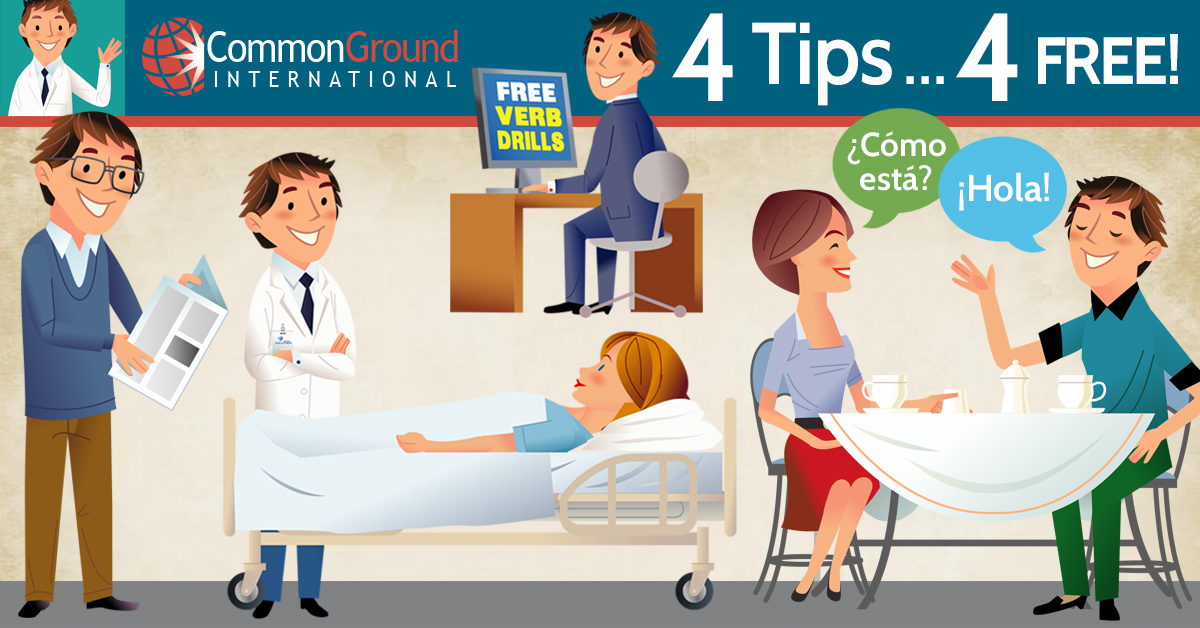When you can’t take a Medical Spanish Class at the moment, or you need to brush up between classes; what is the best way to study Medical Spanish on your own?

Of course there are hundreds of software programs out there to learn Spanish that combine language drills with vocabulary acquisition, and recently more are adding an interactive component as well. The new trend is to connect you up with some sort of Skype tutor or something similar. These programs are mostly fine for general Spanish study. Each one has its pros and cons, you just need to evaluate what works best for you. Among other things, you’ll need to decide if you want to purchase software or subscribe to a monthly membership site. If you think this is a good route for you, a simple Google search on learn Spanish will give you all the options you could ever dream of. Of course, if you’re looking for a Spanish tutor, definitely give a look at our face to face and online Spanish tutoring options.
Before you purchase anything – keep reading! You may not need a pre-packaged Spanish learning system. You can probably keep your Spanish active and limit your backsliding until your your next Spanish class for free. Here are 4 tips to help you study medical Spanish:
Here is the lesson I taught to the Learning Medical Spanish Facebook Group:
Subscribe to our YouTube Channel to see all of our lessons and get the latest videos right away!
Tip #1: Study Relevant Spanish Vocabulary:
Learning Spanish vocabulary that is relevant to your intended USE with Spanish is intrinsically motivating and gives you immediate results. It’s motivating because no one has to convince you that you need to learn these words in Spanish; you are aware of WHY you need to know them and how you’ll benefit from using them! If you’re learning Spanish so that you can travel, you’re going to want to study transportation, food/restaurant, weather and sight-seeing vocabulary and phrases. Sure there’s more to learn, but this will be a good start for you.
Most of our students are learning Medical Spanish so they can improve the level of interactions they’re having with their Spanish Speaking Only (SSO) patients. Your first step in studying medical Spanish on your own is to think through your everyday interactions with Spanish speaking patients and begin to categorize the vocabulary you need to know to help those interactions. If you are a diabetes educator, your vocabulary list is going to be very different from the OB nurse’s vocabulary list.
We’ve committed to uploading relevant vocabulary to Quizlet.com for the public to study. If you’re looking for some great medical Spanish vocabulary lists – check out what we have uploaded under the name CGISPANISH. If you’re not familiar with Quizlet already, you’ll want to get familiar with it. you can get a free app for iOS or Android and study all the medical Spanish vocabulary you could ever dream of!
Since the original publish of this post, we’ve also added a new page on our site that lists free downloadables for learning medical Spanish. Every month we add a new freebie just for you… Get your free medical Spanish tools here!
Tip #2: Use Free Verb Drills to Master Verb Tenses:
Modern language learning techniques really frown on verb drills in the Spanish classroom. We agree; there are better ways to use the expertise of your Spanish teacher in class than to spend a significant portion of your time doing verb drills. You need enough guided practice in class to understand what is happening with a particular verb conjugation, but you get more out of speaking Spanish in class than you do working verbs with a pencil and paper.
StudySpanish.com is a great resource for free verb drills. You can read a quick lesson on verb tense use and conjugations, and then generate self-study quizzes to practice. It’s definitely worth your time to see if it will meet your needs.
If you prefer the pen and paper approach, we recommend The Ultimate Spanish Review and Practice book. It is 400+ pages of Spanish grammar review and practice activities. All of the answers are listed in the back of the book so you can check your work, and there is an interactive CD that comes with the book for additional practice as well. It’s not free of course, but for $22 you can study a lot of Spanish!
Tip #3: Read in Spanish:
Students routinely ask us if we recommend a particular TV program or radio station to listen to so they can improve their Spanish. I love the motivation here because people naturally know that they need to be receiving Spanish input to learn Spanish. The caveat is that the input has to be comprehensible. The honest truth is that TV and radio are great for the advanced Spanish student but are completely frustrating for anyone mid-intermediate and below; it’s just too fast and the content is so varied that you need a pretty expansive vocabulary to make sense of what people are talking about. The alternative would be a TV or radio program on the level of Dora the Explorer. Instead of subjecting yourself to that, find something to read!
Reading in Spanish is great because you get to moderate the speed of that comprehensible input so that you can actually learn from it. There are endless resources online to find something to read in Spanish. Treat this like your vocabulary study, find something relevant to your intended USE of Spanish. A few quick ideas for you:
-
- Your hospital or clinic may already have patient educational brochures in Spanish. Read those! They most likely have something to do with the work you do with patients – so you know it will be relevant! If your employer doesn’t have any basic patient education information in Spanish, you might suggest that they contact me for Spanish translation services. It’s inexpensive; there really isn’t any reason to not have documents in Spanish if you have SSO patients.
- Find healthcare information in Spanish online. There are several sites that provide tons of information in Spanish:
- WebMD has a news section in Spanish. They don’t have all of their information in Spanish but the news updates are interesting. If you like to stay current on healthcare news anyway, this is a great option for you because you’ve likely read this information somewhere else in English first.
- National Institute of Health has information in Spanish.
- MedlinePlus has a great deal of information as well.
Remember, the trick here is to find something relevant for you and your professional work to read in Spanish. If it’s not relevant you’ll bore quickly.
Also – please don’t use a translator to help you understand what you need to look up while you’re reading. Here is why you should use a Spanish dictionary instead of a Spanish translator.
Tip #4: Find Someone to Speak Spanish With:
You can’t study medical Spanish ad infinitum – you need to practice speaking Spanish as well. This can be tricky because research shows that how people react to you speaking a second language can have a big impact on your willingness to continue speaking. In language learning circles we call this the Affective Filter. Basically, if you’re anxious about practicing Spanish because you know that the other person is going to stop you and correct you incessantly, laugh at you, etc. – you’re not going to take any language “risks” and you’ll shut down. So, you need to pick your conversation partner wisely.
Here are some quick ideas – but this can be complicated so it probably deserves a full blog post to be honest:
-
- Ask a friend or a colleague who has similar goals to study medical Spanish to commit to a weekly coffee break in Spanish with you. You can help each other.
- Try a Meetup Group in your area – but beware that some of them are sponsored by companies that will try to sell you on their services.
- Find native Spanish speaker in your everyday circle that might allow you to invitar them to a coffee in exchange for some conversation. Note: invitar in Spanish means you buy
- Consider working out some sort of language exchange with someone in your everyday circle. You can help them with English and they can help you with Spanish. If you’re both good at the natural give and take involved, it might be a great collaboration.
When you’re engaging a conversation partner who is not a trained language teacher, try to avoid the “why” questions when it comes to grammar. Unless they had to study Spanish the same way you are, they will likely not know the answer. This is one of the points I’ll be elaborating in a future blog, but the quick and dirty reason is that you run the risk of getting the wrong reason & learning bad grammar that you later need to unlearn because you’re applying it to situations where it doesn’t work. And then there is that classic answer that is ever-frustrating: “It just sounds better”.
In summary, you have many resources at your disposal to study medical Spanish for free while you’re between classes or while you’re waiting for your schedule to clear up. A little self-study will go a long way in keeping you from backsliding and it is sure to give you the confidence you need to jump into the next medical Spanish class that rolls around.
Of course if you know you want to Study Medical Spanish in Colorado, we’d be happy to work you into one of our classes. They’re super fun and engaging – you won’t regret it! We’d also love for you to study Medical Spanish in Costa Rica with us. We travel 2 times a year on our medical Spanish immersion programs; these are trips of a lifetime and the progress you make with medical Spanish is unmatched by any self-study or traditional class back home!
Whatever you do, do something to keep studying medical Spanish! It makes a difference in people’s lives who are sick and hurting – and you’re awesome for spending your time and energy this way!
Btw: If you’re working on learning Spanish for your healthcare career, we have the medical Spanish you need!
Feel free to comment and share other tips to study medical Spanish for free – we love to hear from you!





I´m not sure that general learning tools as duolingo are so efficient in this case.. maybe for learning basic grammar is good, but you need yo take special courses to learn specific vocabulary
I believe I can learn from all four types